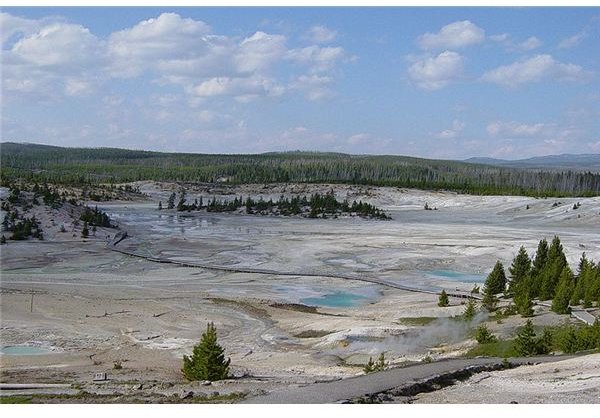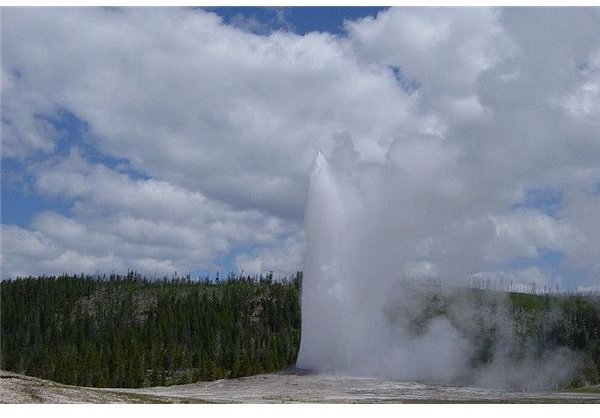Geysers: What They Are, How They Form & the Yellowstone Super Volcano - Is It About to Erupt?
What are Geysers?
Geysers are considered natural phenomena – they can spew boiling hot water by thousands of gallons that reach several hundred feet in height, as the Earth’s surface periodically goes into eruption. If you’re wondering what geysers are, they are outlets in order to expel some of Earth’s inner pressures.
It’s not a coincidence that geyser locations are in close proximity to volcanic areas. These conditions can make the metals and rocks near the Earth’s core really hot. The Earth’s inner composition is made up of groundwater as well as several layers of land between the Earth’s crust and its core, while beneath them are the water reservoir and the hot rocks or magma. You could just imagine the amount of heat that is trapped between these layers as the hot rocks cause the water reservoir to boil and build-up steam pressure underneath.
How and Why are Geysers Formed?
Since we have established the fact that geysers are formed as an outlet for the pressure build-up underneath the Earth’s crust, we should also make it clear that geysers do not just erupt at will or at random places. The steam pressure has to reach groundwater level and get trapped between the ground surface and the Earth’s layers.
However, there are fissures or narrow shafts existing in between the Earth’s layers, and these fissures will serve like exhaust systems to release the pressures of hot steam. Meanwhile, the water reservoir underneath the groundwater surface and layers of land will reach its boiling hot stage as it comes in contact with the hot rocks. The heat and steam pressure created will escape through the fissures until it reaches the groundwater level.
As the heat reaches groundwater, the latter will also boil creating more heat and steam pressure but is already trapped just below the Earth’s crust. Due to this, pressures of great magnitude build up, and can only find release once the amount of pressure is great enough to create ground eruption. Once eruption takes place, the trapped steam pressure will spew several thousands of gallons of boiling hot water, thrusting it many hundreds of feet above the ground.
Thus, a geyser has formed and soon after, regular eruptions of steaming and boiling hot water will be released. This is a natural occurrence in order to lessen the steam pressure that builds up near the Earth’s core, since there are hot rocks or magma that keep the water reservoir boiling.
Geyser eruptions can be quite spectacular. In fact, the “Old Faithful Geyser” has become a regular attraction at Yellowstone National Park. Most of those who visit the national park go out of their way just to see “Old Faithful” spew out gigantic fountains of steaming hot water.
The Impact of Climate Changes and Global Warming

Initially, “Old Faithful” at Yellowstone National Park was monitored to erupt every 15 minutes, as recently as 1998. National Geographic’s records showed that gradual changes in eruption intervals took these eruption intervals to 90 minutes by 2006. These changes did not cause much concern until other geysers in the area, particularly the Daisy Geyser, also showed signs of slowing down in eruption intervals, from 40 minutes to almost three hours.
The National Geographic team had attributed these changes to global warming and its resulting climate changes. It is said that the area around Yellowstone National Park was going through a dry spell. However, this still baffled the research team because not all geysers were responding to the dry spell. If there were not enough water reservoirs to cause an adequate amount of boiling steam, then there was not enough pressure building up between the Earth’s core and the Earth’s crust. This should be true in other geysers if climate change and dry spells are to be pinpointed as causes.
However, other areas near Yellowstone National Park manifested a different activity. The nearby Norris Geyser basin which used to be made up of dried up and dormant geysers slowly sprung into life and began spewing up hot springs. Speculations began to surface that the area around the “Yellowstone Caldera” was beginning to bulge.
What is a caldera? A caldera is the volcanic area itself and is marked by a slight indentation atop the mountain because it used to be the volcanic crater.
Is the Dormant “Yellowstone Super Volcano” About to Erupt?
The formation of geysers has led us to look at where all that hot steam is coming from — the volcano.
As events in history have it, the Yellowstone Super Volcano erupts at an interval of between 600,000 to 800,000 years. Currently, it has been more than 650,000 years since the super volcano has erupted. Linking the unusual geyser activities to the volcano has sparked much discussion and debate among the scientific community.

As recently as 2003, those who were speculating that the Yellowstone Super Volcano was showing signs of eruptions were called amateur geologists regardless of their scientific background. Thus, their geological findings and analyses were scoffed at, and not given much bearing.
In 2004, the Yellowstone Volcano Observatory maintained that it has been monitoring geological changes in the park and any imminent threats of eruption will not go unmonitored by the observatory’s modern instruments.
Today however, further developments in the super volcano and the surrounding areas, consistently show signs that there is indeed imminent threat of volcanic eruptions of great magnitudes. This is why many have been researching and studying the role of geysers more closely.
Why Is the Yellowstone Volcano Called a Super Volcano?
A super volcano has a different structure than the regular volcano we all know of.
The regular volcano has an open crater where the hot rocks have an exit point as steam pressure pushes them up to the Earth’s surface in the form of hot lava or molten rocks.
A super volcano, on the other hand, releseases heat and steam pressure build-up through outlying geysers. The molten rocks, however, stay underneath; slowly piling up through the years, until they have built up enough pressure to spew out of the blocked crater called a caldera.
The caldera, which appears as an indentation on the Earth’s surface, is formed by the residue of dried-up lava and magma that remained at the peak after the volcano last erupted. In the case of the Yellowstone Super Volcano - that was 650,000 years ago. Its crater formed a cone which gave the volcano the appearance of a regular mountain.
Evidence that this super volcano will soon erupt is now supported by the following indicators:
- The Eastern Space Agency’s satellite images have shown that there are heat or gas movements beneath the Yellowstone Caldera, at approximately 15 kilometers deep or an estimated equivalent of 9 miles.
- In 2009, over 500 earthquakes were recorded in the Yellowstone National Park Area.
- Beginning February of 2010, 1,000 earthquakes have been registered at the Yellowstone Super Volcano with the largest magnitude posted at 4.0+
- The caldera indentation continues to show signs of swelling since 2004: In 2011, it was reported that between 2004 and 2010, some parts of the ground around Yellowstone’s supervolcano rose by ten inches
When Will the Yellowstone Super Volcano Erupt?
In another 2010 publication, regarding a question as to when Yellowstone will erupt, the Discovery Channel stated through its Research Geologist that scientists will be able to determine in advance if indeed an imminent catastrophic eruption is about to take place. Scientists at the Yellowstone Volcano Observatory closely monitor any significant shift in gas chemistry, rise in the caldera’s indentation and thermal features of the Yellowstone Volcano. For other questions you may have regarding the super volcano’s eruption, you will find additional insight provided at “Discovery Channel’s Answers from the Experts”.
The debates about whether this supervolcano will erupt continue to ebb and flow, depending on activity at the site and the activeness of seismic activity overall.
Ironically, the alternative possibility, the the super volcano will not erupt, presents an equally devastating scenario. If the heat and gas accumulated through all the past 650,000 years that the Yellowstone supervolcano has lain dormant cannot find a release, the pressures will create tectonic forces that can cause earthquakes that can open up fractures on the Earth’s surface.
Now that you know more about geysers and how they are formed, it’s easier to comprehend what seems to be brewing inside that famous geyser, “Old Faithful”.
References
-
Reference Materials:
- What is a Geyser?
http://geology.com/articles/geyser.shtml - Yellowstone Volcano - Question and Answers -
http://www.nps.gov/yell/naturescience/volcanoqa.htm - Satellite Technologies Detect Uplift in the Yellowstone Caldera -
http://volcanoes.usgs.gov/yvo/2006/uplift.html - Yellowstone Volcano Observatory Monthly Update -
http://volcanoes.usgs.gov/yvo/activity/ - Yellowstone Has Bulged as Magma Pocket Swells -
http://news.nationalgeographic.com/news/2011/01/110119-yellowstone-park-supervolcano-eruption-magma-science/
Images courtesy of Wikimedia Commons
- What is a Geyser?
This post is part of the series: All About Geysers
In this series, you will learn about geysers-what they are, how they are formed and the conditions necessary for this to occur, how they erupt, and other interesting geyser facts.
